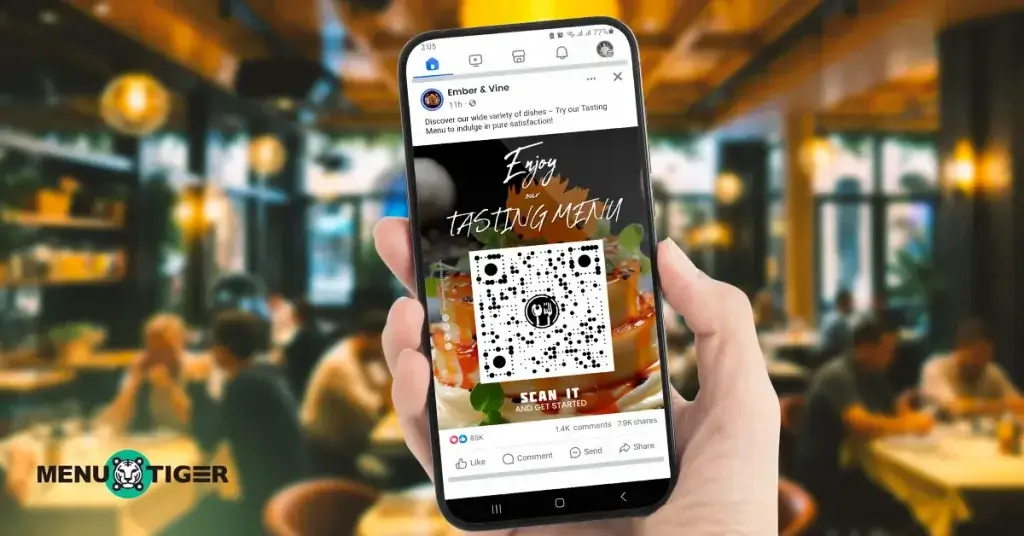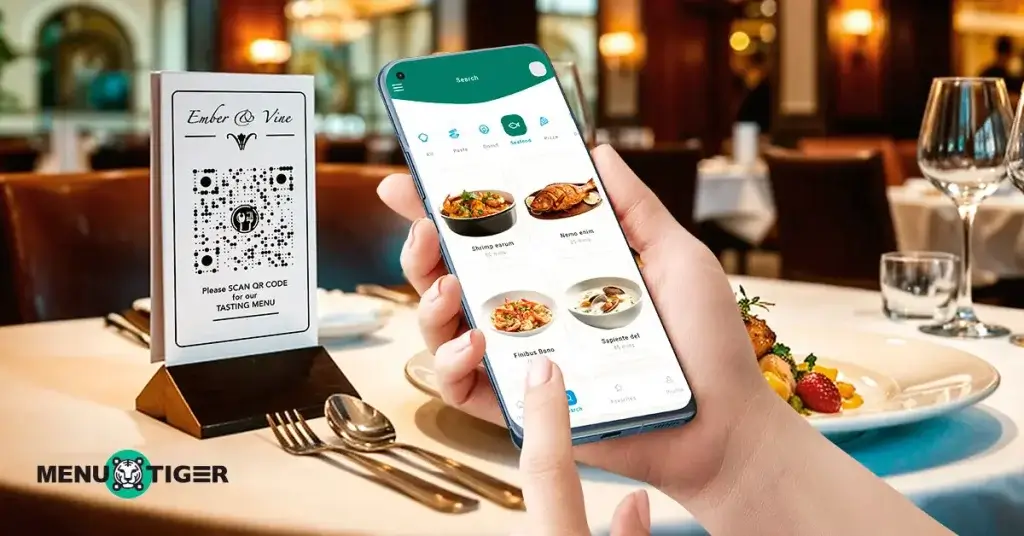A tasting menu is ideal for showcasing your trademark dishes and attracting foodies and critics who are eager to experience a filling multi-course meal.
The good thing about this is you can increase revenue and improve service effectiveness by making the most of your team. Reducing the number of unique, big-portioned meals on the menu helps the kitchen anticipate preparation times more precisely, which expedites the ordering and serving process.
If you want to try this for your restaurant but don’t know where to start, you’ve landed on the right page.
We’ve covered everything you need to know to build and serve this type of menu to your customers, plus ways on how you can digitize it through an interactive restaurant menu software.
What is a tasting menu?

A tasting menu comprises many small plates presented to customers as a single course. Their concept came from the French word ‘dégustation,’ which refers to the purposeful tasting of several dishes with a focus on the senses and culinary art.
It’s also known as a prix fixe (French for ‘fixed price’), set menu, or dégustation menu.
It is, in essence, a way to pay for an experience rather than just a meal.
While a full-course dinner typically consists of four courses, some tasting menus may offer a refined 5 course meal or even up to twenty dishes distributed over a longer duration.
What is the difference between à la carte and tasting (dégustation) menu?
When you do a head-to-head comparison between two restaurant services, you mainly want to look into their menu structure, restaurant menu pricing strategies, and guest experience.
An à la carte menu allows diners to select individual dishes from a broader selection, each priced separately.
This gives guests the flexibility to customize their meals based on their preferences, allowing them to choose how many courses they want and what specific dishes appeal to them.
It’s a more casual and adaptable dining experience where the customer has full control over their order.
In contrast, a tasting (dégustation) menu is a pre-set, multi-course meal curated by the chef.
Think of it this way: instead of picking dishes, guests are taken on a culinary journey, experiencing a series of small, thoughtfully designed courses in a specific sequence.
Dégustation menus showcase the chef’s creativity and skills, offering a cohesive, often more luxurious experience.
Pricing is typically fixed, and the overall restaurant cost tends to be higher, reflecting the exclusivity of the meal and higher profit margin. While à la carte is about choice and flexibility, a tasting or prix fixe menu offers a structured, immersive dining experience.
Benefits of a dégustation menu
If done well, a menu degustation can positively affect your business. Discussing these potential advantages with your chef is crucial as you plan your cuisine.
Predictable costs and efficiency
A fixed menu allows the kitchen staff to work more efficiently. They can prepare ingredients in bulk and follow a streamlined process, reducing prep time, enhancing consistency, and allowing smoother service.
Also, remember that a fixed menu = controlled inventory.
Since the menu offers a selection of dishes, you can more accurately predict ingredient usage and reduce food waste in your restaurant.
Higher per-customer revenue
A set menu allows you to charge a premium by showcasing your chef’s creativity and expertise in a multi-course service.
This can result in higher average revenue per customer compared to à la carte.
What’s even better is it opens upselling opportunities. You can pair your menu items with wine or beverages, which further increases the per-guest check total.
Simplified staffing
Since the menu is predetermined, your waitstaff doesn’t need to spend as much time explaining each dish or taking complex orders.
This reduces the workload and training requirements for front-of-house staff, allowing them to focus on enhancing the overall guest experience.
How to prepare a restaurant tasting or prix fixe menu for your customers
A dégustation menu is not as simple as picking and slicing a few favorite dishes into small portions. It is important to remember that you are making a culinary experience rather than just merely putting together a meal.
This section will take you through the eight processes of creating a restaurant menu, regardless of whether you’re launching a new location or updating an old one.
Describe the concept of your restaurant
A clear restaurant menu idea is essential before developing an online menu since it establishes the framework for your business’s operations.
A defined idea influences operational choices and marketing tactics and helps form your restaurant’s menu. Attracting the proper audience and attaining long-term success depends on this alignment.
Decide the menu theme and layout
One of the trickiest tasks in the process is deciding what to include on your menu. The meals you choose to include may vary depending on several factors, such as the time of year, the available resources, and any restaurant themes you may wish to incorporate.
Having a solid understanding of visual hierarchy is essential to designing digital or traditional restaurant menus that work. It guarantees that your primary meals are the first to draw attention and that your menu items are simple to traverse.
Categorization is essential when choosing the best menu template to fit the scope of your offers. It helps prevent overpowering patrons, particularly in restaurants with wide menus. Make a list of every food and drink you intend to serve first.
Select tasting menu courses

A decent tasting menu courses selection should be varied enough to satisfy many palates.
However, having too many choices is inefficient. They can complicate inventory management, slow down the kitchen, and make it more difficult for patrons to choose what to eat.
Your menu should, therefore, be brief yet varied enough to appeal to a wide range of patrons. For instance, it may combine both cutting-edge choices and well-known favorites.
Organize the menu
Making a prix fixe menu experience requires choosing how many courses to serve after deciding on how to arrange your menu. Remember that this menu doesn’t have to have a certain number of courses.
Smaller restaurants or menus designed to serve fewer patrons will probably have fewer courses than an established restaurant, which could contemplate offering up to ten dishes throughout the set menu.
Choose the highlight
Choosing which dishes to feature is one of the most crucial steps in putting together a dégustation menu.
Depending on how you want to create the menu, this might change.
One typical example is showcasing your chef’s skills and creativity or perhaps introducing new menu items. This could include seasonal specialties or limited-time offerings, like popular Mother’s Day or Father’s Day restaurant specials.
Design the menu
Cuisine is the focal point of your service and the factor that entices people to come. But remember that menu themes or designs that align with your branding also affect the overall experience of your guests.
This means that when producing your printed or digital menu, make sure that the aesthetics blend well with the ambiance you are creating.
The next thing to consider is providing four to six bite-sized pieces on your menu for a well-rounded experience.
Finding a happy medium between house specialties and creative small plates can encourage customers to try more of your food. Additionally, you may use data-driven meal planning.
Price your menu items
Customer satisfaction is one factor to consider when implementing menu pricing strategies. This is because the pricing you establish may impact how buyers see the worth and quality of your product.
Do a thorough cost analysis of each dish before you decide on the appropriate price.
Recognize the most lucrative recipes by considering the cost of materials, processing time, and other overheads. These specifics can also help you determine which menu items require pricing changes or ingredient rearranging to keep a healthy profit.
Be aware that more expensive and less expensive interactive restaurant technology will have quite different pricing schemes.
Launch your menu for a trial
Testing your menu before the launch is essential to collect early feedback and make any required corrections. Organizing a soft launch or a run of tasting events for loved ones and influential people can yield a wealth of information on the usability and popularity of your menu.
Advertise your menu

It is essential to promote your service actively to guarantee good foot traffic and table turnover rate.
Use every tool available to you. Promote the event and emphasize the restaurant themes, cuisine, and price to engage your social media followers right away.
Other suggestions include sending out an email marketing campaign to your current customers and collaborating with regional food bloggers or influencers for focused advertising. The more effort you can put into marketing your event, the more likely it is to succeed.

How to serve a dégustation menu to your customers
Now that you understand what will be on the menu and to whom you will serve it, you can focus on serving your guests’ meals.
Recall that the highlight of a menu ought to be the meal itself. Ensure that there is little external disruption so that attendees can savor every bite of each meal.
Offer palate cleaners
To help your guests appreciate each meal entirely, try serving a palette cleanser before a new dish comes.
They strive to erase any aftertastes left on the tongue so that diners may enjoy each meal without continuing to taste the last.
However, be careful when selecting a palette cleanser that has a relatively neutral flavor. Sparkling water, ginger tea, celery sticks, and even champagne are a few of the often-served palate cleanser options.
Presentation of the menu
To evoke a feeling of culinary creativity in every meal, consider presenting it on more straightforward, smaller plates. This will assist your visitors in focusing more on the meal’s appearance and feel than the dishes it is served on.
Additionally, you can ensure that your visitors appreciate the range of meals they will be given and keep a selection of eating utensils accessible.
Personnel and materials
To begin arranging a tasting service, you must first create a management and operational plan.
Minimal resources are needed for smaller, more personal menu tastings; consider fine china, flatware, serving utensils, and glasses. If your service is bigger than expected, think about your area and available equipment to see if you can add more seats, tables, or serving utensils.
In the same way, consider adding accent items to your set menu, such as tablecloths and centerpieces.
As you know, having dependable, well-trained, and satisfied staff is essential to running any business.
A well-oiled staff guarantees a smooth sailing service. Pay attention to the many aspects of your presentation while organizing your event workers, such as food preparation, service, and bussing.
Upgrading your menu with a QR code menu software

Some diners may feel that using technology detracts from the luxurious, intimate nature of fine dining, which is where set menus are usually served.
To combat this, consider integrating a QR code menu into elegant, tasteful elements like customized napkin rings or sleek, branded table cards.
Here’s an elaborate look at the advantages and considerations:
Enhanced customization and flexibility
One of the many benefits of QR code menu solutions is that they allow you to easily update your menu items, prices, and availability based on seasonality and practicality. You can also tailor the digital menu to display curated options, wine pairings, or specific dietary restrictions.
This is perfect for restaurants where dishes may vary frequently.
Interactive storytelling
You can improve the dining experience by including videos, chef’s notes, or behind-the-scenes stories of the dishes or ingredients. This adds depth to the presentation without interrupting the ambiance, allowing diners to explore more if they wish.
Even better, if your restaurant offers food and drink pairing ideas, you can incorporate expert insights or sommelier recommendations digitally.
Sleek, minimalist table setting
Fine dining thrives on presentation, and fusing your printed menus with a QR-coded one creates a more refined and uncluttered table.
Rather than displaying large, wordy menus, a smaller version would do.
You see, a discreet QR code can be incorporated into the design without minimizing the elegance of the setting.

Experience elevated dining and boost profits with a set menu and QR code integration
If you want to make your dining extra special, tasting menu is the way to go.
It’s like taking your customers on a culinary adventure where they get to try a bunch of your specials and show off your chef’s skills. Plus, with a QR code menu system, your guests can easily explore your menu and learn about each dish.
It’s a win-win: you get to impress your customers and make more money, and they get a unique experience.
So, why not give it a shot?
FAQs
A 5-course menu tasting typically includes:
1. Appetizer: A small, flavorful starter to stimulate the palate.
2. Fish Course: A light, often delicate seafood dish.
3. Meat Course: A richer, heartier dish featuring meat.
4. Cheese Course: A selection of cheeses, sometimes served with accompaniments.
5. Dessert: A sweet ending showcasing creativity and flavor.
Each course is usually paired with a complementary wine or beverage. The menu is designed to provide a balanced and varied dining experience.
Tasting menus are usually designed for one person, but they can be served to multiple people at the same table.



